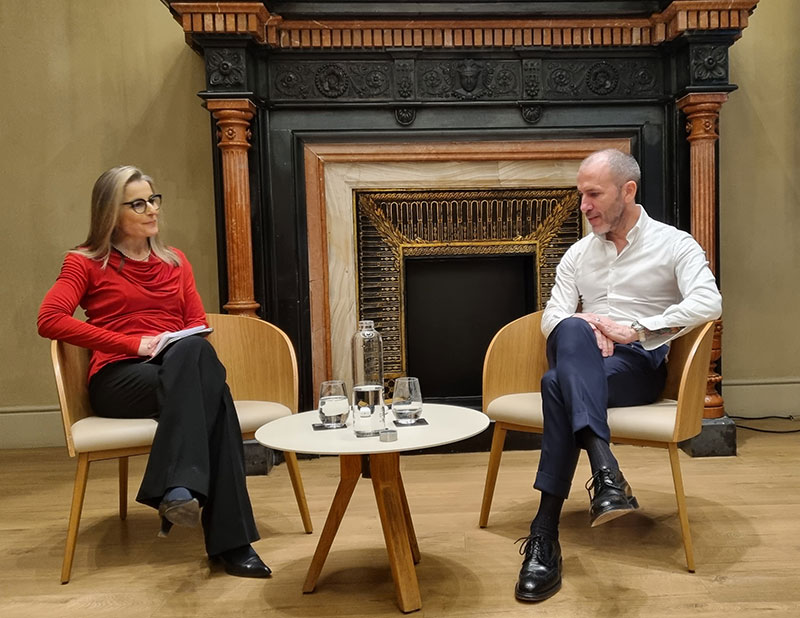A 20-year veteran of TIM, Labriola took over as CEO in January of 2022 after several successful years in the company’s Brazil unit, first as COO and later CEO. He is now heading the company’s efforts to sell its massive Italian landline network grid in an effort to reduce the firm’s debt.

Emanuela Aureli, leader of Spencer Stuart’s Telecommunications, Media & Technology Practice for Europe, the Middle East and Africa, sat down with Labriola at MWC to talk about the challenges and opportunities within the telecommunications industry today and Labriola’s approach to leadership at one of the world’s top telecom companies. Below is a transcript of the conversation, edited for clarity and brevity.
Let's start with the macro picture. What do you think are the biggest challenges and biggest opportunities for the European telecommunications industry in general today?
The telco market in Europe faces a perfect storm. Energy prices are increasing, but our industry does not benefit from the same fiscal advantages that others do. There’s inflation, which is difficult when contracts lack inflation adjustments. How do you share those costs?
Then there’s debt and rising interest rates, which will be particularly important because of the amount of capex investment needed over the next several years to upgrade networks. A private equity partner may prove necessary in this area because they can borrow more cheaply.
In particular, we must restructure the consumer business, which is the hardest place to make money. We have to look past the myth that some wonderful innovation will save us. Half a billion euros just came off our books because the company once had the “wonderful” idea of buying football rights. Other telco players also lost a lot of money on content. Content is a business where you burn value, and some people in the telco sector don’t seem to have learned that lesson.
In Europe, we need market repair. Europe has more than 120 telco players. The U.S.? Three. Brazil? Three. China? Three. The market share isn’t big enough for everyone to survive; having five mobile networks in each European country is not sustainable. Consolidation is the only way to fund the capex needed. In the next three to five years, I think there will be a lot of M&A in Europe.
How does regulation impact the market?
Our market is hyper-regulated, but unequally so. Compare your Netflix contract with the one you have with your phone operator. Netflix is not required to communicate pricing changes the way a telco must. Meanwhile, we carry much of the burden of network capabilities for the content being sent out. We need more equal conditions in this market.
In the new digital world, it is common to charge the supplier of the services and the person who uses the service — think of how Uber charges the customer a fee and also takes a fee from the driver. Yet telcos cannot charge the over-the-top (OTT) providers — only the customer, even though that provider and a few others account for a huge slice of overall network usage.
Regulation needs to keep pace with all these changes. In Brazil we had a sophisticated relationship with regulators, which helped both manage different situations more effectively. In Europe, it feels like we stay on opposite sides of a wall.
Inaction is no longer an option. Distributors, operators and regulators need to work together to solve the big issues.
You are describing a high level of complexity. When you look at yourself as CEO, how is your role shifting? What leadership qualities do you need to be successful?
No leader is a perfect fit for every individual condition a company may face. Sometimes you need a politician’s capabilities. Sometimes you need a CFO’s.
With better conditions in the past, a CEO could let executives do their own thing in marketing, sales, network, etc. Today, the level of coordination necessary makes that impossible. The CEO has to understand everything well, because the pace at which we need to adapt and to change things is so fast.
You need to be braver. You need to be able to make a bold decision. That is what I’m trying to do with our company.
Like a racing team — there’s a driver, and then there’s the guy who puts fuel in the car, the ones that work on the tires. Each needs to understand their specific role and that they cannot make decisions without everyone’s buy-in. That also means putting people in a position where they can exchange ideas with each other. In that way, the CEO is more like an orchestra director. This is how I think about my job.
I have also started to promote some second-line leaders. First of all, I want everyone in our company to know they can have the dream to grow within this company. Beyond that, TIM is a complex organization. Experience is important. If you haven’t been around long enough to know how it all fits together, you will never succeed.
You are unconventional, especially in an Italian market that is pretty traditional — for example, you have tattoos. How does that image help attract younger, more innovative people to your organization?
Forty percent of a company’s public image comes from the public image of the CEO. Early in my role, I used to cover my tattoos, but I started showing more of myself eventually. I want to build an image of our company as one focused on the future, not stuck in the past.
The average age in our company is 55 years old. But I also meet with younger colleagues. If they understand you are a leader who is comfortable discussing issues with people three or four levels below the C-suite, if they are at ease speaking with the boss about their work, I believe that can only be helpful in building a sense that as a company we’re on the right track.